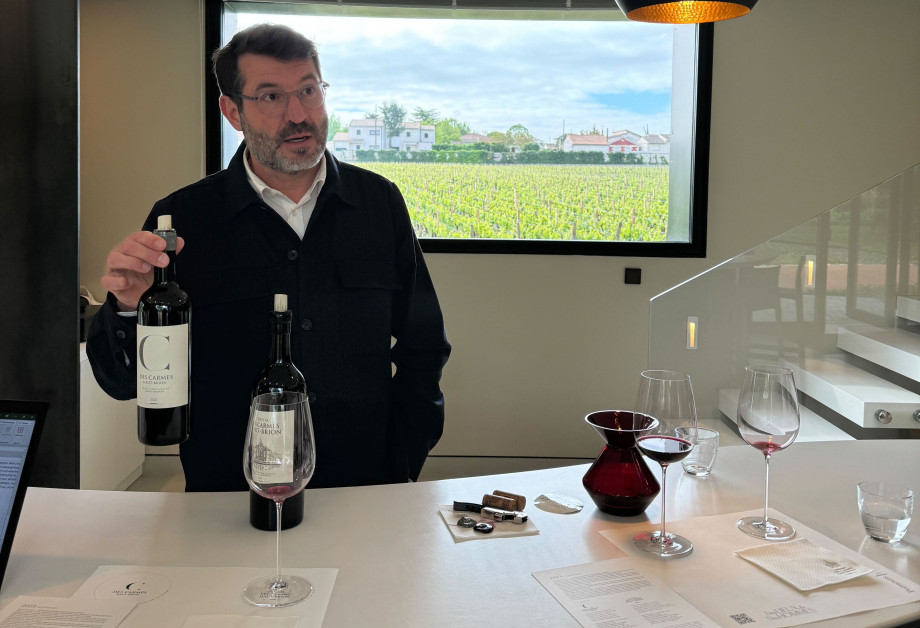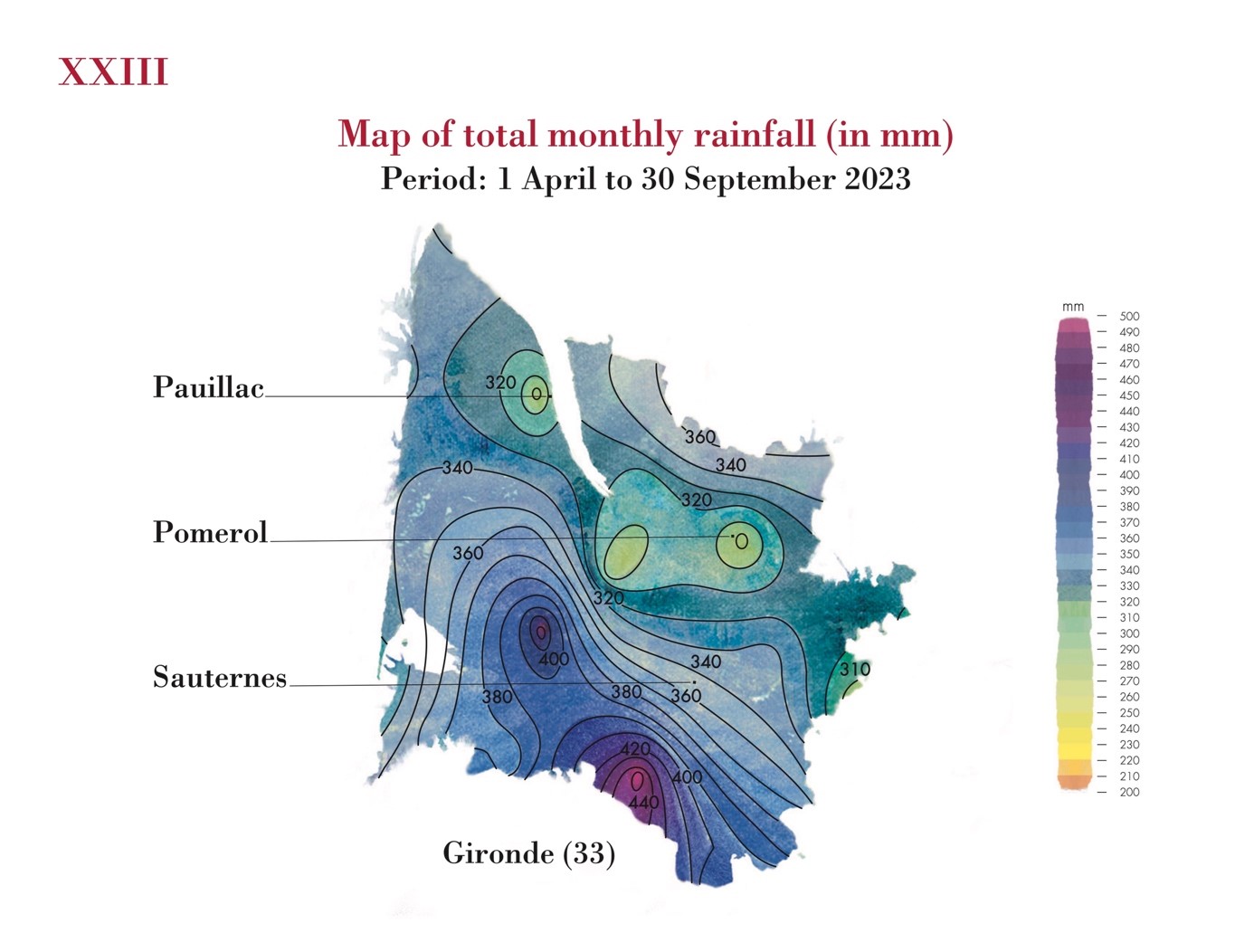Now that Le Figaro has released more than 500 tasting notes and scores, the French newspaper’s lead taster and Wine Lister’s CEO, Ella Lister, shares her summary of the vintage from a quality and style perspective. She and her colleague, Béatrice Delamotte, spent 11 days in Bordeaux, tasting for 111 hours, covering 1,135 kilometres, visiting 72 châteaux, and discussing the vintage with 84 producers. They tasted 534 en primeur samples, mostly together, and often several times, in order to provide as objective an assessment as possible.
There are no norms in the 2023 vintage, but many brilliant wines that express their terroir and the microclimate of the year – vastly different from one vineyard to the next. Upon arriving in Bordeaux, what was immediately striking was that the reality on the ground rarely tallied with the statistics: a dry growing season on average nonetheless yielded extreme mildew pressure, while the second-hottest year on record produced wines with “cool weather expression,” in the words of Jean-Emmanuel Danjoy, Estate Manager at Château Mouton Rothschild.
The vintage is hard to pin down, for some recalling the 2019 (“though not the same,” caveats Christian Seely, CEO of AXA Millésimes), and others 2016 (“even if 2016 was more concentrated,” notes Philippe Bascaules Managing Director at Château Margaux). In Pomerol, Alexandre Thienpont of Vieux Château Certan notes 2023’s pedigree, in “total contrast with the exuberant 2022”, and playfully cites 1953 and 1988 as comparable vintages, while Léoville Las Cases write on their tasting booklet: “This vintage reminds us of the 1771”. Not the most helpful reference for common mortals, but the point is made that this vintage evades comparison.
Seely summarises 2023 as granting “periods of freshness and rain at the right time, and a first half of August that made it possible to make wines that were perfectly ripe and had enough of the sunshine character of the year, but also had freshness and balance and harmony.”
Weather conditions allowed the terroir to shine through, rather than dominating the character of the wine. For Pierre-Olivier Clouet, Technical Director at Cheval Blanc, 2023 is “more about terroir expression than vintage expression,” in comparison to 2022 or 2018, adding “2022 is a very nice wine but it's more 2022 than Cheval Blanc.” At Château Ausone, Constance Vauthier marvelled at the” “completely unique character of each of our wines”.
The 2023 vintage is also one of varied microclimatic expression, with sometimes dramatically different conditions from one appellation to another. This was hammered home looking at the rain map from April to September displayed by Domaines Barons de Rothschild for their properties in Pomerol (well under 300mm), Pauillac (around 300mm), and Sauternes (350mm). At Château Montrose in Saint-Estèphe, for example, they had a lot less rain than other appellations, especially in June, and less than average rainfall from April to August, leading Pierre Graffeuille to call 2023 a “hot, dry vintage.”
Credit: Météo France for Domaines Barons de Rothschild (Lafite)
While generalisations are therefore unwise in such a heterogenous vintage, there are patterns common to many wines: a long, temperate growing season has resulted in full phenolic ripeness and high tannin indices on paper, combined with moderate alcohol levels. The most successful wines belie their analytical make-up, with satisfyingly chewy, yet delectable, succulent, silky tannins despite the high polyphenolic content. “The Damocles’ sword was not to extract too much tannin,” explained Benjamin Laforêt, Research and Development Technical Coordinator at Château Angélus.
Though not felt in the better wines, these high levels of tannin can be overpowering and even rustic in the less successful examples. Others quickly adjusted their vinification techniques. “On the first batches we realised extraction was coming fast, so we did a third less pumping over,” recounted Guillaume Thienpont, consultant winemaker at Le Pin. Down the road at Petrus, winemaker Olivier Berrouet was “amazed by the tannic concentration,” so immediately slowed down the volumes of pumping over. “This meant a longer maceration, but we moved the wine less.” In Pessac Léognan, Fabien Teitgen, Managing Director at Smith Haut-Lafitte, concurred: “In 2023 the extractability was incredible, even more than 2022, so we had to be very soft with extraction.”
Also common to most properties (though with certain exceptions) were long harvests and generous yields. Most châteaux we visited recounted longer harvests than average, or even their longest ever, which was the case at Haut-Brion, running from 21st August for the whites and finishing on 4th October for the reds. Even at bijou properties like Beauséjour in Saint-Émilion, picking lasted nine days versus five on average. At Pontet-Canet, harvest lasted 34 days, more than double the usual 12-15. As owner Alfred Tesseron explained, this allowed them “to go in search of grapes wherever they were ripe.”
And there were lots of grapes to pick. At Calon-Ségur, Estate Manager, Vincent Millet hadn’t seen such high yields since 2017. At 45 hl/ha, the property’s yields are representative of many other Cru Classé neighbours in the Médoc. Even organic estates were able to fend off mildew sufficiently to attain abundant yields, with 45 hl/ha at Duhart-Milon and Lafite, and a whopping 53 hl/ha at biodynamic Haut-Bages Libéral, a fact of which Claire Villars-Lurton is immensely proud, as testament to the ability of biodynamic farming to be increasingly resilient the longer it has been in place. Even at Palmer, where yields have been notoriously low over recent years, they managed 32 hl/ha under biodynamics. “We managed the mildew properly this year,” said Managing Director, Thomas Duroux, adding with relief, “we can cover the whole vineyard in six hours now.”
At Ducru-Beaucaillou, Special Advisor on Wine and Markets, Tracey Dobbin MW said the “mildew was easier to control than in 2021.” Nonetheless, controlling it required significant resources for many properties, and some who could not field teams to spray at all the right times lost a high proportion of grapes. “We had to work very, very hard,” recalled Constance Vauthier at Château Ausone. Even for those with less rainfall (for many, the growing season was dryer than average), the high quantity of residual moisture in the soil after heavy rain earlier in the year, combined with hot temperatures, made for conditions which many Bordelais described as “tropical”.
CEO and Director General of Lafite-Rothschild, Saskia de Rothschild told us water management was the key to the vintage. At Les Carmes Haut-Brion, Managing Director, Guillaume Pouthier seconded this statement, underlining the importance of evapotranspiration, and citing several solutions to tackle an excess of water in the ground at the beginning of the season, including cover crops to absorb water, pruning the vines into a Christmas tree shape so water evaporates more easily from the leaves, and working the soil in the early morning to encourage evaporation during the day.
Others were more sanguine about the mildew threat. “We seem to have mildew every spring now,” said Bascaules, who notes rather, “the main problem for us was sunburn.” Nobody was expecting the heatwave that hit at the end of August, and many had removed leaf cover to counter the humidity and allow air flow through the vines, so grapes were left without protection from the hot sun. Nonetheless, this hot, dry fortnight was a blessing, “allowing the plants to sweat out a lot of water,” in Teitgen’s words. “The ball was on the net like in the film Match Point,” recalls Duroux, nail-bitingly. “We really needed that heatwave, to have vines that would invest their energy in the fruit and not on leaf production anymore,” he explained.
Omri Ram, Research and Development Manager & Sales Manager at Château Lafleur, went further: “Until mid-August, we thought the semi-tropical conditions would give a super-duper 2012, ripe and round, but not deep or layered. The two heat spikes late August totally transfigured the style of the wines. We gained layers of complexity and minerality, moving the wines from very good to potentially great.” And so, 2023 was a year of meticulous selection, weeding out the grapes affected by mildew, and sun damage.
The wines display a certain classicism in their freshness, moderate alcohol levels, and with a welcome touch of austerity. For Hubert de Boüard, co-owner at Angélus, they’re “classy wines” rather than classic wines, the latter being “more 2019 or 2001”. But the wines are also modern: precise, silky, and saline. “This vintage is the new style of Bordeaux, not the dense, powerful, oaky wine of 20 years ago,” concludes Pouthier.
So perhaps the most apt tagline for the 2023 vintage in Bordeaux is that chosen by Pichon Comtesse on their tasting booklet: back to the future.
You can discover the hundreds of tasting notes on the Wine Lister and Figaro Vin websites now, including one potentially perfect wine.

